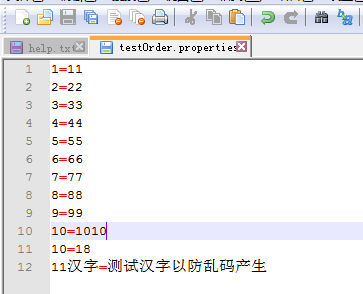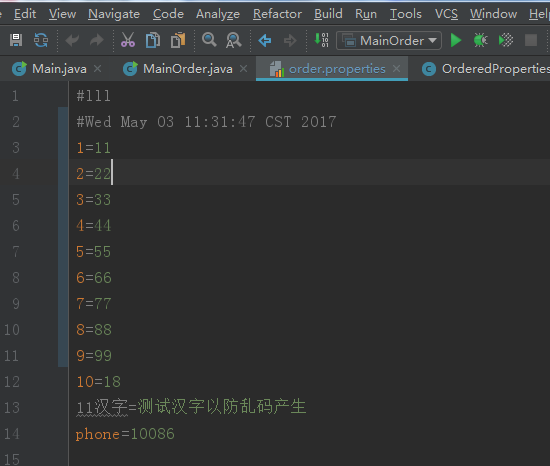最近遇到一项需求,要求把properties文件中的内容读取出来供用户修改,修改完后需要再重新保存到properties文件中。很简单的需求吧,可问题是properties是继承自hashtable的,直接通过keyset()、keys()或entryset()方法对properties中的元素进行遍历时取出来的内容顺序与properties文件中的顺序不一致,这是问题一;问题二是就算取出来的时候是有序的,保存到文件中时又是无序的了。
当然,解决这两个问题的方法有很多。我最终采用的方法是自定义一个propertiesutil类,该类继承自properties。propertiesutil提供一个返回由key按照存入顺序组成的list的方法,getkeylist(),这样问题一就解决了。那如何保证getkeylist()方法返回的就是有序的key组成的集合呢?我查看了一下properties方法的源码,发现其setproperty()方法实际上就是调用了父类hashtable的put()方法,其次properties在从文件中加载内容时是按照文件顺序进行读取,然后调用父类hashtable的put()方法进行储存。所以问题的解决办法就是propertiesutil持有一个私有的可以有序存储key的集合,然后重写父类的put()方法,在方法体中照常通过super.put()进行属性的存储,同时将key添加到存储key的集合中。
properties提供有save()方法和store()方法可以将当前对象的内容存放到指定的输出流中,但它们的底层逻辑都是一样的。通过调用keys()方法获取一个enumeration,然后对该enumeration进行遍历,依次将对应的key和value写入到输出流中,所以要保证写入是有序的,就要保证遍历keys()返回的enumeration时取出的元素key是有序的。所以解决方法是重写keys()方法,保证遍历返回的enumeration时得到的key是有序的。
下面就示范怎么按顺序读properties文件,以及还得按原来的顺序写properties文件。
|
1
2
3
4
5
6
7
8
9
10
11
12
13
14
15
16
17
18
19
20
21
22
23
24
25
26
27
28
29
30
31
32
33
34
35
36
37
38
39
40
41
42
43
44
45
46
47
48
49
50
51
52
53
54
55
56
57
58
59
60
61
62
63
64
65
66
67
68
69
70
71
72
|
package com.lxk.propertyfiletest;
import java.util.*;
/**
* created by lxk on 2017/5/2
*/
public class orderedproperties extends properties {
private static final long serialversionuid = -4627607243846121965l;
/**
* 因为linkedhashset有序,所以,key在调用put()的时候,存放到这里也就有序。
*/
private final linkedhashset<object> keys = new linkedhashset<>();
@override
public enumeration<object> keys() {
return collections.enumeration(keys);
}
/**
* 在put的时候,只是把key有序的存到{@link orderedproperties#keys}
* 取值的时候,根据有序的keys,可以有序的取出所有value
* 依然调用父类的put方法,也就是key value 键值对还是存在hashtable里.
* 只是现在多了个存key的属性{@link orderedproperties#keys}
*/
@override
public object put(object key, object value) {
keys.add(key);
return super.put(key, value);
}
/**
* 因为复写了这个方法,在(方式一)的时候,才输出有序。
* {@link mainorder#printprop}
*/
@override
public set<string> stringpropertynames() {
set<string> set = new linkedhashset<>();
for (object key : this.keys) {
set.add((string) key);
}
return set;
}
/**
* 因为复写了这个方法,在(方式二)的时候,才输出有序。
* {@link mainorder#printprop}
*/
@override
public set<object> keyset() {
return keys;
}
//这个就不设置有序了,因为涉及到hashtable内部类:entryset,不好复写。
//public linkedhashset<map.entry<object, object>> entryset() {
// linkedhashset<map.entry<object, object>> entryset = new linkedhashset<>();
// for (object key : keys) {
//
// }
// return entryset;
//}
/**
* 因为复写了这个方法,在(方式四)的时候,才输出有序。
* {@link mainorder#printprop}
*/
@override
public enumeration<?> propertynames() {
return collections.enumeration(keys);
}
}
|
上面是继承java自带的类,我们做的主要是实现有序,其他的还是原来的样子就行。
看下整个的类继承关系:如下图:
下面是main方法的类。
|
1
2
3
4
5
6
7
8
9
10
11
12
13
14
15
16
17
18
19
20
21
22
23
24
25
26
27
28
29
30
31
32
33
34
35
36
37
38
39
40
41
42
43
44
45
46
47
48
49
50
51
52
53
54
55
56
57
58
59
60
61
62
63
64
65
66
67
68
69
70
71
72
73
74
75
76
77
78
79
80
81
82
83
84
85
86
87
88
89
90
91
92
93
94
95
96
97
98
99
100
101
102
|
package com.lxk.propertyfiletest;
import java.io.*;
import java.util.enumeration;
import java.util.map;
import java.util.properties;
import java.util.set;
/**
* 读写properties文件测试(带顺序的读和写)
* <p>
* created by lxk on 2017/5/2
*/
public class mainorder {
public static void main(string[] args) {
properties prop = readorderedpropertiesfile();
printprop(prop);
writeorderedpropertiesfile(prop);
}
/**
* 输出properties的key和value
*/
public static void printprop(properties properties) {
system.out.println("---------(方式一)------------");
for (string key : properties.stringpropertynames()) {
system.out.println(key + "=" + properties.getproperty(key));
}
system.out.println("---------(方式二)------------");
set<object> keys = properties.keyset();//返回属性key的集合
for (object key : keys) {
system.out.println(key.tostring() + "=" + properties.get(key));
}
system.out.println("---------(方式三)------------");
set<map.entry<object, object>> entryset = properties.entryset();//返回的属性键值对实体
for (map.entry<object, object> entry : entryset) {
system.out.println(entry.getkey() + "=" + entry.getvalue());
}
system.out.println("---------(方式四)------------");
enumeration<?> e = properties.propertynames();
while (e.hasmoreelements()) {
string key = (string) e.nextelement();
string value = properties.getproperty(key);
system.out.println(key + "=" + value);
}
}
/**
* 读properties文件(有序)
*/
private static properties readorderedpropertiesfile() {
properties properties = new orderedproperties();
inputstreamreader inputstreamreader = null;
try {
inputstream inputstream = new bufferedinputstream(new fileinputstream("d:testorder.properties"));
//prop.load(in);//直接这么写,如果properties文件中有汉子,则汉字会乱码。因为未设置编码格式。
inputstreamreader = new inputstreamreader(inputstream, "utf-8");
properties.load(inputstreamreader);
} catch (exception e) {
system.out.println(e.getmessage());
} finally {
if (inputstreamreader != null) {
try {
inputstreamreader.close();
} catch (ioexception e) {
system.out.println(e.getmessage());
}
}
}
return properties;
}
/**
* 写properties文件(有序)
*/
private static void writeorderedpropertiesfile(properties properties) {
properties.setproperty("phone", "10086");
outputstreamwriter outputstreamwriter = null;
try {
//保存属性到b.properties文件
fileoutputstream fileoutputstream = new fileoutputstream("order.properties", false);//true表示追加打开,false每次都是清空再重写
//prop.store(ofile, "此参数是保存生成properties文件中第一行的注释说明文字");//这个会两个地方乱码
//prop.store(new outputstreamwriter(ofile, "utf-8"), "汉字乱码");//这个就是生成的properties文件中第一行的注释文字乱码
outputstreamwriter = new outputstreamwriter(fileoutputstream, "utf-8");
properties.store(outputstreamwriter, "lll");
} catch (exception e) {
system.out.println(e.getmessage());
} finally {
if (outputstreamwriter != null) {
try {
outputstreamwriter.close();
} catch (ioexception e) {
system.out.println(e.getmessage());
}
}
}
}
}
|
其实读和写,都和使用系统提供的类的差别不大,只是现在读到了我们自己写的子类里面去了。
其他的代码都是一样样的。
下面是读的文件的内容截图:
再然后是,实际代码运行的结果截图:
|
1
2
3
4
5
6
7
8
9
10
11
12
13
14
15
16
17
18
19
20
21
22
23
24
25
26
27
28
29
30
31
32
33
34
35
36
37
38
39
40
41
42
43
44
45
46
47
48
|
---------(方式一)------------
1=11
2=22
3=33
4=44
5=55
6=66
7=77
8=88
9=99
10=18
11汉字=测试汉字以防乱码产生
---------(方式二)------------
1=11
2=22
3=33
4=44
5=55
6=66
7=77
8=88
9=99
10=18
11汉字=测试汉字以防乱码产生
---------(方式三)------------
11汉字=测试汉字以防乱码产生
9=99
8=88
7=77
6=66
5=55
4=44
3=33
2=22
10=18
1=11
---------(方式四)------------
1=11
2=22
3=33
4=44
5=55
6=66
7=77
8=88
9=99
10=18
11汉字=测试汉字以防乱码产生
|
额,太长了,就不截图了吧,就给把打印结果给展示一下得了。
可以看到,只有第三次是无序的,具体原因,我也在代码里面解释过了。
还有,就是生成的文件的截图:
以上就是本文的全部内容,希望对大家的学习有所帮助,也希望大家多多支持快网idc。
原文链接:http://blog.csdn.net/qq_27093465/article/details/71108520
相关文章
- ASP.NET自助建站系统的数据库备份与恢复操作指南 2025-06-10
- 个人网站服务器域名解析设置指南:从购买到绑定全流程 2025-06-10
- 个人网站搭建:如何挑选具有弹性扩展能力的服务器? 2025-06-10
- 个人服务器网站搭建:如何选择适合自己的建站程序或框架? 2025-06-10
- 64M VPS建站:能否支持高流量网站运行? 2025-06-10
- 2025-07-10 怎样使用阿里云的安全工具进行服务器漏洞扫描和修复?
- 2025-07-10 怎样使用命令行工具优化Linux云服务器的Ping性能?
- 2025-07-10 怎样使用Xshell连接华为云服务器,实现高效远程管理?
- 2025-07-10 怎样利用云服务器D盘搭建稳定、高效的网站托管环境?
- 2025-07-10 怎样使用阿里云的安全组功能来增强服务器防火墙的安全性?
快网idc优惠网
QQ交流群
-
centos7使用docker部署gitlab-ce-zh应用详解
2025-05-25 57 -
2025-06-04 14
-
2025-05-25 72
-
2025-05-29 72
-
2025-05-27 53













